
views
X
Research source
You can eat kimchi on its own, or you can use it to make rice, noodles, and soup, for instance. Grab chopsticks or a fork and dig in!
Eating Kimchi Plain
Eat kimchi out of the jar for an effortless snack. Kimchi is ready to eat fresh out of the jar! Grab a fork, twist off the lid, and take a bite. Kimchi by itself pairs great with Korean BBQ.

Serve individual pieces of kimchi with toothpicks to easily share it. Scoop the cabbage out of the jar, and pierce each piece with a single toothpick. Then, arrange each piece on a plate, and serve them as bite-sized snacks. This is a great idea for a dinner party.
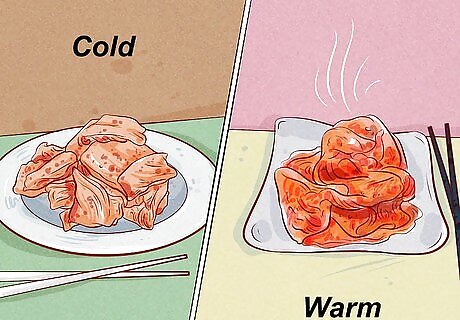
Enjoy plain kimchi cold or warmed up. You can eat kimchi straight out of the fridge, or you can throw it in a small skillet and heat it up with 1 US tbsp (15 mL) of vegetable oil. It tastes great both ways! Some people prefer the cold, spicy taste, while others find the tangy texture best when heated up.
Serving Kimchi with Breakfast
Scramble your eggs with kimchi to take them up a notch. Before you make your eggs, slice your kimchi into bite-sized pieces with a sharp, serrated knife. Then, prepare your eggs on medium heat, and mix your kimchi into your egg batter. Cook your eggs for about 2-4 minutes, or until the liquid is completely solid. Use about 1/4-1 cup (59.2-236.6 grams) of kimchi for 2-3 large eggs, based on personal taste preference. If you'd like, throw your kimchi egg scramble into a tortilla with some sliced avocado to easily make a breakfast taco.

Stuff your omelet with kimchi for a spicy addition. Heat up a 2-3 egg omelet in a medium skillet, and add 1/4-1 cup (59.2-236.6 grams) of kimchi when you mix in your favorite toppings. Then, fold over your omelet and serve it on a plate. This is a great idea to add spice to your omelet rather than topping it with hot sauce or sriracha. Other yummy toppings you can pair with kimchi include arugula, bacon, or ham.
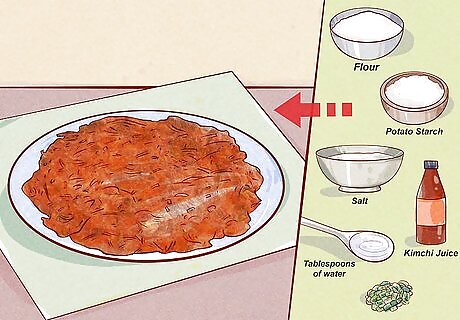
Try kimchi pancakes for a crunchy, savory dish. Mix together 1/2 cup (118.3 grams) of flour, 1/2 cup (118.3 grams) of potato starch, and 1/4 tsp (1.2 g) of salt in a large bowl. Then, add 1/2 cup (118.3 grams) of kimchi, 1/2 cup (120 mL) of kimchi juice, 3 tablespoons (44 mL) of water, and 1 chopped scallion. Mix it all together, and add the batter to a warmed pan. Fry 1 side until it is brown, and flip it over to fry the other side. To make a dipping sauce, add together 1 tablespoon (15 mL) of soy sauce, 1 tablespoon (15 mL) of water, 1 teaspoon (4.9 mL) of rice vinegar, and ⁄2 teaspoon (2.5 mL) of sesame oil.
Having Kimchi with Dinner
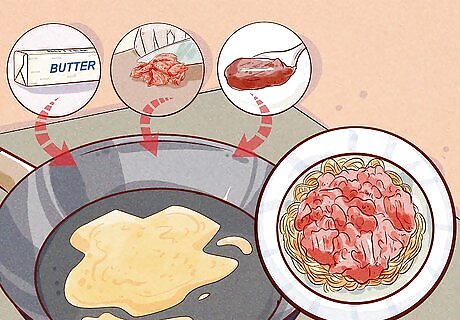
Mix kimchi and butter to make your own spicy pasta sauce. To make a yummy, savory sauce, finely chop up 1 cup (236.6 grams) of kimchi using a sharp, serrated knife. Then, warm up 1 stick of butter on medium heat. As the butter heats up, mix your chopped kimchi into the butter. Then, add 2 tbsp (30 grams) of gochujang, ⁄2 cup (120 mL) of broth, and ⁄3 cup (79 mL) of kimchi juice. Simmer this for about 3-5 minutes to finish your sauce. Then, you can serve your sauce over udon, rice, or spaghetti noodles. To make the sauce in advance, pour the sauce into a glass jar and refrigerate it for no more than 1 week. You can freeze the sauce for up to 1 month.
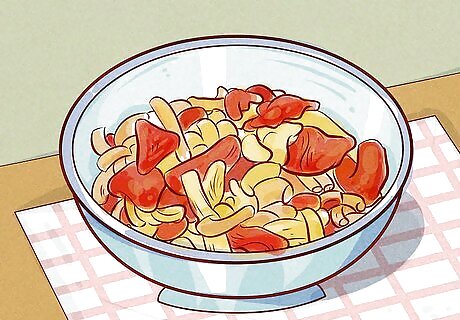
Add kimchi to your mac and cheese for a spicy twist. Pour half of your mac and cheese across the bottom of a baking dish, and top the mac and cheese with an even layer of kimchi (about 1/4 cup or 3312.2 grams). Add the rest of your mac and cheese over top, and then pour another 1/4 cup (3312.2 grams) of kimchi over top. Sprinkle on some shredded cheese if you'd like, and make the dish at 400 °F (204 °C) for 25 minutes. If you'd like, you can garnish the dish with chopped jalepeño, basil, and cilantro. You can either make boxed macaroni and cheese, homemade mac and cheese, or purchase store-made mac and cheese.

Serve kimchi over lettuce to make Korean lettuce wraps. Rip off leaves from a head of lettuce, and wash them in cool water. Then, mix together ⁄4 cup (59 mL) of apple cider vinegar and 2 tablespoons (30 mL) of honey. Grab a bowl, pour in your cooked protein, and add in your kimchi. Pour the mixture over top and mix it thoroughly. Finally, scoop your mixture equally over 8-12 leaves of lettuce. You can choose from protein options including cooked tofu, chicken, pork, or beef along with your kimchi. To eat, wrap the contents up in the lettuce and take a bite!
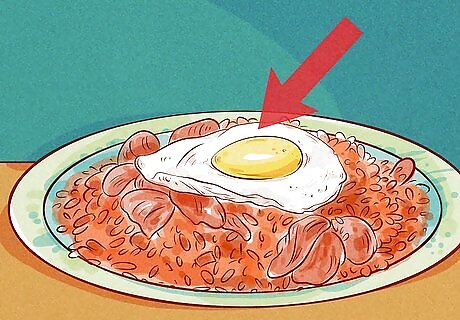
Make kimchi fried rice for a tangy dish. First, make 1 cup (236.6 grams) of white rice. Then, add diced onion, garlic, and scallion to the pan and heat for about 1 minute. Mix in your kimchi and rice, and fry the mixture for 5-10 minutes. Garnish the dish with your fried egg, silver nori, and sesame seeds. If you'd like, you can add soy sauce or sriracha sauce to give your dish extra flavor. Silver nori is a form of dried seaweed. You can customize your fried rice by adding or subtracting any ingredient.

Top your stir fry with kimchi to add spice to your meal. You can either make a vegetable stir fry or chicken stir fry, for example. Chop up your desired vegetables with a large serrated knife so they are in about 1 in (2.5 cm) chunks. Serve your stir fry over prepared white rice, and add about 1/4 cup (59.2 grams) of cold kimchi on top. Alternatively, you can cook your kimchi into your stir fry for extra spice. To do this, add about 1 cup (236.6 grams) of kimchi to your vegetables when you start to warm them up. This cooks the vegetables in the kimchi flavor, giving the dish a bold, tangy taste. You can stir fry vegetables including broccoli, carrots, snap peas, edamame, and corn.
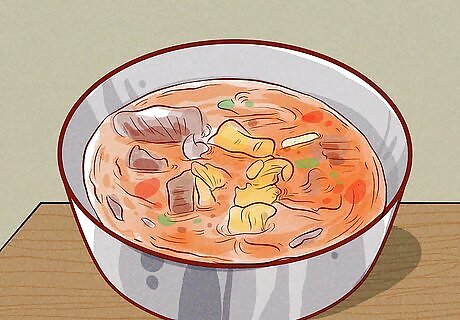
Add kimchi to stew for a spicy touch. For an easy, quick option, make your soup base, and add 4 cups (946.4 grams) of kimchi after your soup begins to boil. After about 5 minutes, add 1 cup (240 mL) of kimchi juice for extra flavoring. Bring your mixture to a boil, and simmer for 35 minutes. If you'd like, you can season with salt and pepper, and top each bowl with a fried egg yolk and sesame seeds. There are countless Korean stew recipes you can try. Add your favorite ingredients to this recipe, or search online for other Korean stew recipes.




















Comments
0 comment